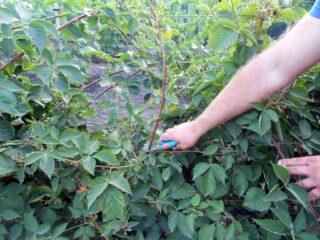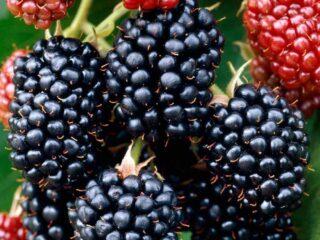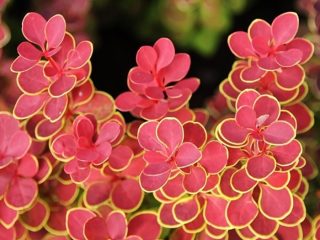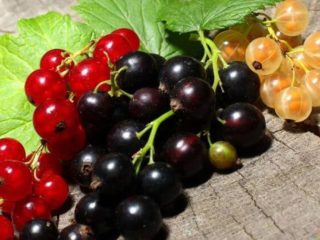Content
- 1 Breeding history
- 2 Description of the Tyberry variety
- 3 Ezemalina Tayberry traits
- 4 Advantages and disadvantages of the variety
- 5 Planting the Tayberry Ezemalina
- 6 Tayberry Nezemalina Care
- 7 Reproduction of the Tayberry nezemalina
- 8 Why does the Tayberry Ezemalina not bear fruit
- 9 Conclusion
- 10 Reviews of the raspberry-blackberry hybrid Tayberry
Ezhemalina Tayberry (Tayberry) - an unusual variety of shrubs, in recent years, more and more found in personal plots. Summer residents who have acquired a plant are mostly satisfied with the purchase. The culture is not particularly demanding, it bears fruit well, it looks beautiful and decorative on the site.
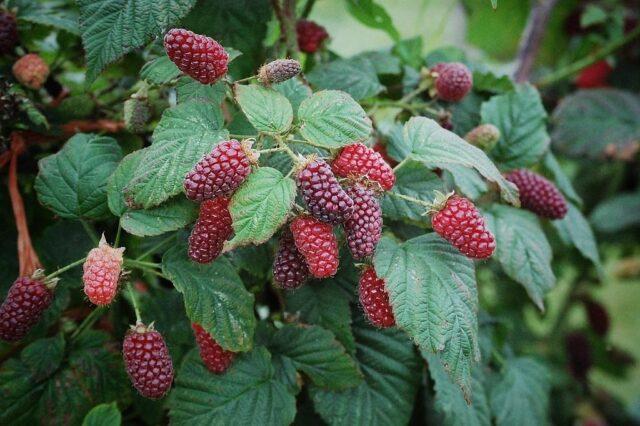
Among all varieties of culture, the Tayberry Yezemalina is the most popular
Breeding history
The plant was bred in 1981 in California by Scottish breeder Jennings. The scientist spent 19 years to get a seedling of a hybrid of raspberry and blackberry Tiberry. During the experiments, he crossed the cultivated raspberry variety Malling Jewel and the wild blackberry Aurora. As a result of research, the variety took the best qualities from the "parents": raspberry sweetness and softness, blackberry strength, flexibility of branches and caramel aftertaste.
Description of the Tyberry variety
A hybrid of the Tayberry Yezemalin, the video and photo of which are presented below, is a high-yielding, early ripe, unpretentious, with powerful bushes and large berries.
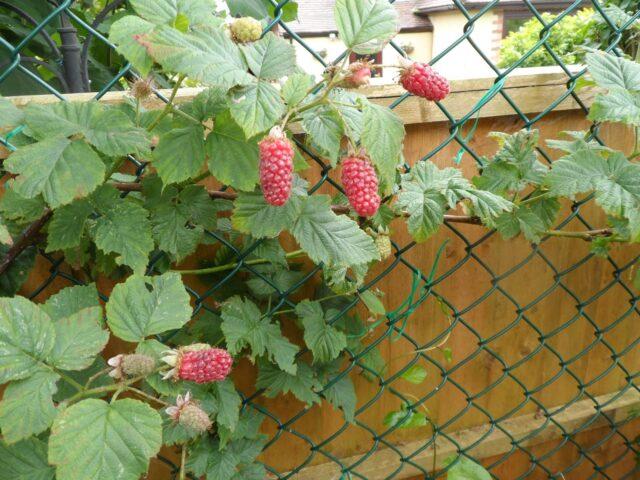
The plant can be used as a hedge
The fruits of the plant are very tasty fresh, and are also suitable for making compotes, jams, baking. The berry lies for a long time, does not lose its qualities after freezing.
The appearance of the bush
Ezhemalina Tayberry has powerful stems of the creeping type, the length of which can reach 4 m. They are thick and resilient, but elastic enough, they easily fall down and are removed from the trellis. Small spines are located along their entire length. Annual shoots are green, two-year-old and older than light burgundy. The foliage is dark green with jagged edges. The buds are large, pale pink in color. The lateral branches grow up to 300 cm in length, so in the fall the Tayberry Jagger needs to be pruned.
Description and taste of berries
The fruits of the culture are elongated, large - up to 6 cm in length, weighing about 10 g. Their color is from bright red to dark cherry with a shine inherited from blackberries. The leaves do not hide the berries of the Tayberry, it is clearly visible in the photo of the bush, it is convenient to remove them from the branches.
Ezhemalin tastes sweet and sour, with a candy aftertaste. The pulp contains small bones, like raspberries. The crop is harvested with a stalk, which is not felt in the mouth while eating. The berry can be transported over long distances, it does not lose its shape and taste during transportation.

In a cool place, the crop is stored for a week.
Ezemalina Tayberry traits
The hybrid is an early maturing crop. The harvest period depends on the growing region, but always takes place in the summer. Ezhemalina Tayberry grows in all areas, with good cover, it easily tolerates frost. If you provide the plant with proper care, then it will not hurt and be exposed to pests.
Flowering period, ripening period and yield
Ezhemalina Tayberry begins to bloom in May-June, budding lasts for a month.At this moment, the bush is especially beautiful. Closer to July, and in some regions in August, the time for the first harvest comes. The fruits ripen gradually, the duration of fruiting is about a month. On average, Tayberry Yazhmalina yields 4-6 kg of berries per season from one bush; under favorable growing conditions, up to 10 kg of harvest can be obtained from an adult plant.
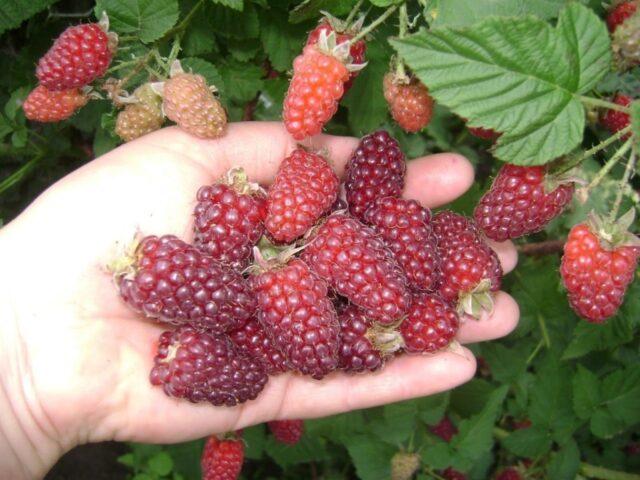
The heyday of Ezemalina Tiberry begins at the age of five
Frost resistance
The resistance of the variety to cold weather is average. It is noteworthy that it can be grown in almost all climatic conditions. The plant adapts perfectly to any terrain. However, the main rule of care: for the winter, the Tayberry must be carefully covered.
Disease and pest resistance
Judging by the description, the culture is practically not exposed to diseases and attacks of pests, does not need preventive treatments. Among the diseases that can be infected with the Tayberry echemaline, it is worth noting only rust, powdery mildew and verticillary wilting. As for insects, crop damage can be caused by weevils, bronzes, gall midges, and a raspberry beetle.
Advantages and disadvantages of the variety
Gardeners who grow the Tayberry jaggery note a lot of its advantages, which are much more than disadvantages.
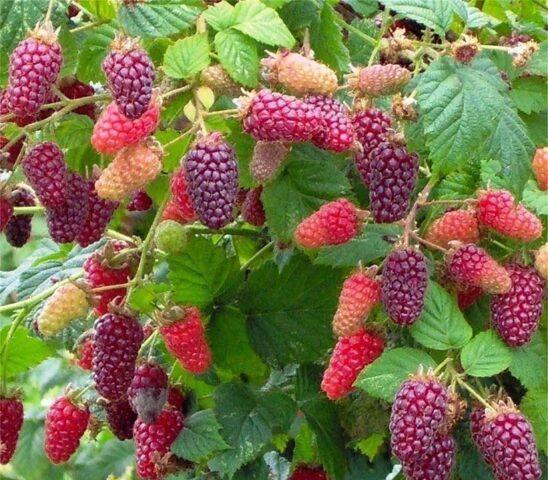
Berries of the culture are very useful both fresh and processed.
Pros:
- early ripening;
- high quality of taste;
- self-fertility;
- ease of growing and care;
- good commercial qualities;
- disease and pest resistance;
- the ability to adapt to any conditions.
Minuses:
- the need for winter shelter;
- high cost of planting material;
- thorns on the shoots.
Planting the Tayberry Ezemalina
In order for the plant to grow and develop well, it should be properly planted. Yezhemalina Tayberry is best taken in the fall. The recommended month is September. It is most likely to start the procedure by choosing a seedling. It is advisable to purchase it in a specialized store or nursery so that the material is certified. The plant must have elastic, moist, well-developed roots, from which at least two living stems with several buds extend.
Ezhemalina Tayberry loves partial shade. If the shrub is planted in the sun, the berries will “bake”, in the shade they will not gain sweetness. It is desirable that loam serves as the soil for the plant. If the earth is acidic, then periodically ash should be added to it. The site is dug up 14 days before planting. After that, holes are made 50 by 50 by 50 cm, a drainage layer is laid on the bottom, sand is poured, a mound is formed from a mixture of soil, potassium and superphosphate, the roots of the plant are distributed from above. The remaining recess is covered with soil, tamped, watered. The shoots are pruned, leaving a length of 30 cm. Further, the site is mulched with straw or peat. Since the Tayberry jaggery grows well, the interval between seedlings is left at least a meter, when planting in rows - 2 m.
Tayberry Nezemalina Care
If the planting of the Tayberry Ezemalina was carried out in the fall, then a shelter is a mandatory rule at the initial stage of agrotechnical measures. With the arrival of spring, further care consists in carrying out such manipulations:
- watering;
- weeding;
- mulching;
- fertilizer;
- pruning;
- topping;
- the formation of bushes on trellises.
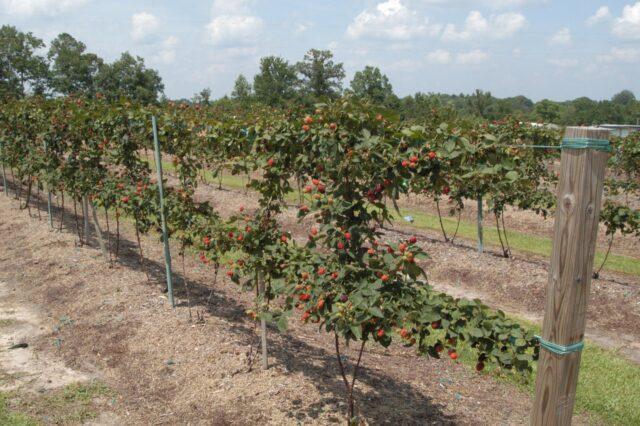
Shrub garter greatly simplifies crop care
Watering
Ezhemalina Tayberry requires moisture as the soil dries up. The procedure is carried out with warm water in the evening, usually 4-5 times per season. After each watering, a layer of mulch up to 15 cm thick is laid on top of the beds.
Tayberry pruning
In most cases, autumn pruning of the Tayberry Ezemalina is carried out in the second half of October.All old stems should be cut off. In addition to pruning, the plant needs to pinch the shoots. This is done when their length reaches two meters or more.
Top dressing
Ezhemalina Tayberry needs fertilization with minerals. They are applied throughout the growing season. The composition is used in granular form for bushes or diluted for spraying. Organic plant nutrition is required only two years after planting. If applied earlier, the bush may lose its winter hardiness.
Preparing for winter Yezemalina Tayberry
In the fall, caring for the Tayberry Bitch is mainly about hiding. In order for the plant to winter well, a sheet of plywood is installed near it, shoots wrapped in non-woven material are laid on it and sprinkled with earth.
Ezemalina Tayberry Trellis Garter
The garter is carried out so that the bushes receive good lighting, they hurt less. Most often, for this, summer residents take a single-lane trellis with 3-5 rows of wire, where the first row is stretched to a height of 100 cm, the second - to 150-200 cm. Fruit-bearing shoots are tied to the upper part, and young ones to the lower.
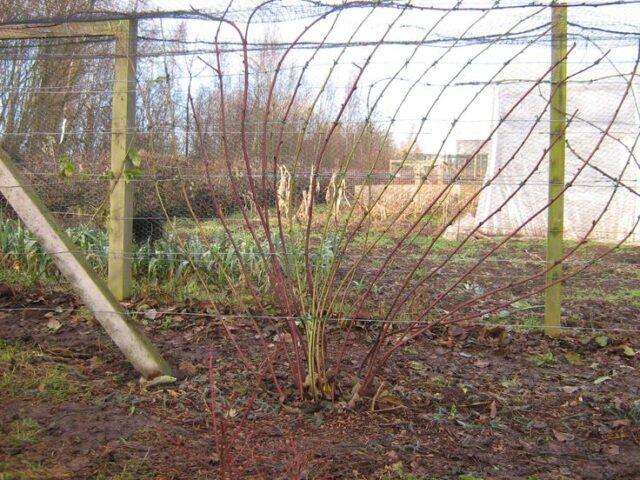
Refined Jemaline bushes give more harvest
Reproduction of the Tayberry nezemalina
The Tayberry Ezemalina reproduces quite simply. Usually it is bred by cuttings or layering, less often by dividing:
- The plant is cut in June. To do this, a stalk with buds is cut off from a young stem, planted in a container with fertile soil, moistened, and covered with a film. A month after the formation of roots, the young plant is planted in a garden bed.
- When propagating by layers, foliage is removed from a healthy Tayberry shoot, at an angle of 450 cut the knot and place it in a hole with sand dug out in advance near the bush. In this case, the free shoot is tied to the support. After a year and a half, the plant is separated from the mother bush and planted in the ground.
- By dividing the rhizome of the ezhemalin Tayberry rarely reproduces. This method requires removing the old bush from the soil, separating its roots and then replanting them.
Why does the Tayberry Ezemalina not bear fruit
Despite all the unpretentiousness of the plant, sometimes gardeners complain that the garden Tayberry is not fruitful. It so happens that there are many flowers, but the berries are not tied. This can happen due to freezing of the buds in spring or winter, the bush is either not covered, or this procedure is poorly performed. In addition, a partial decrease in yield can occur due to damage to the pistils by bronze or the eating of the buds by the strawberry weevil. In this case, it is better to cover the bushes with gauze during the growing season.
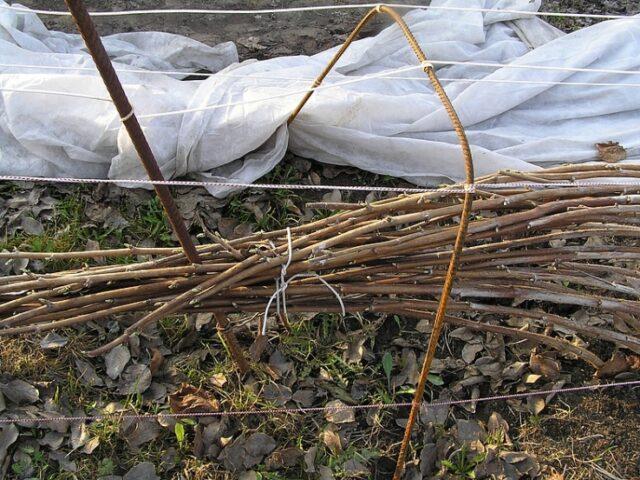
Before the arrival of frost, it is best to insulate the shrub with non-woven material.
Conclusion
Ezhemalina Tayberry is a blackberry hybrid that is very popular among summer residents. The plant has excellent characteristics, it can be grown in almost all regions of Russia. Even a novice gardener can handle it. Ezhemalina is very healthy, contains many vitamins and nutrients.
